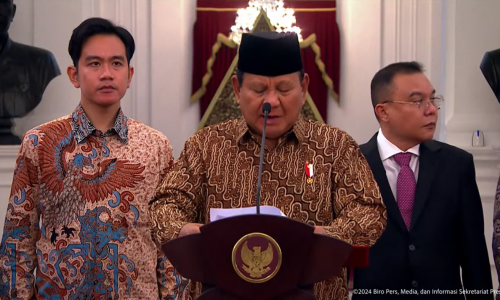Three notable survey institutions had released results of surveys regarding the electability of presidential candidates for the upcoming 2024 Presidential and Vice Presidential Elections.
SMRC’s survey on presidential candidates’ electability among critical voters
On Sunday (28/5), Saiful Mujani Research Center (SMRC) published results of a survey titled ‘Evaluation of the President’s Performance and Preferences for Presidential Candidates in 2024 among Critical Voters’’.
As reported by detik.com, presidential candidate Ganjar Pranowo, endorsed by the Democratic Party of Struggle, scored the highest electability in the survey conducted via telephone from May 23 to May 24, 2023.
Ganjar’s electability stood at 35.9 percent, surpassing Prabowo Subianto, a presidential candidate endorsed by the Gerindra Party, with 32.8 percent electability, and Anies Baswedan, the presidential candidate supported by the Coalition for Change for Unity, with 20.1 percent. Meanwhile, some 11.3 percent of respondents refused to provide an answer.
SMRC Research Director Deni Irvani stated that among critical voters, Ganjar’s electability rose from 31.1 percent to 35.9 percent. Similarly, Prabowo’s electability increased from 29.7 percent to 32.8 percent. Meanwhile, Anies’ electability dropped from 29.7 percent in the December 2022 survey to 20.1 percent in the latest survey conducted from May 23 to May 24, 2023.
Deni explained that critical voters are individuals who have better access to social and political information sources. This is because they have telephones or cellphones, allowing them to access the internet and stay informed about social-political news.
These voters generally belong to the lower-middle to upper-class segments, have higher levels of education, and tend to reside in urban areas. They also have a greater ability to influence the opinions of other voter segments. It is estimated that these critical voters make up around 80 percent of the total electorate nationally.
To ensure representative sampling, the survey employed the random digit dialing (RDD) technique. RDD involves the random generation of telephone numbers to select participants for the survey. Using RDD, a total of 915 respondents were selected through the random generation of telephone numbers.
Insights from Populi Center on electability trends
Populi Center released its latest survey results on the electability of potential presidential candidates for the upcoming year on Monday (29/5). Prabowo emerged as the frontrunner, surpassing his closest rivals, Ganjar and Anies.
The survey was conducted nationwide from May 4 to May 12, 2023, with the respondent samples distributed across 38 provinces in Indonesia, including the four new autonomous regions, namely Central Papua, Southwest Papua, Mountainous Papua, and South Papua.
Data collection for this survey was done through face-to-face interviews with 1,200 respondents selected using multistage random sampling, using the Populi Center survey application.
A researcher at Populi Center Rafif Pamenang Imawan, stated that in terms of the electability of presidential candidates, the data indicates an increase in the electability of Prabowo Subianto. In the top-of-mind question, Prabowo Subianto was the most selected figure by the public as the preferred president if the presidential election were held today, with 22.8 percent.
In the simulation involving three names, Prabowo maintains the highest electability, occupying the first position. Ganjar and Anies secure the second and third positions, respectively. The breakdown is as follows:
Prabowo: 35.8 percent
Ganjar: 34.4 percent
Anies: 21.5 percent
Fixpoll’s survey results: electability of potential presidential and vice-presidential candidates in East Java
Survey institution Fixpoll Research and Strategic Consulting, has released its survey results on the electability of potential presidential candidates for the 2024 Presidential and Vice-Presidential Elections in East Java Province.
The survey indicated that Ganjar Pranowo sits on top position followed by Prabowo Subianto and Anies Baswedan.
The survey was conducted from May 9 to May 16, 2023, specifically in East Java Province. A Total of 840 respondents were involved in the survey, which was carried out through face-to-face interviews using questionnaires administered by trained interviewers.
In this survey, respondents were asked with the question, “If you were to come to the polling station and enter the voting booth right now, which of the following four presidential candidates would you choose?”
“Among these four names, Mr. Prabowo ranks first in East Java. Mr. Ganjar ranks second,” Fixpoll Executive Director Muhammad Anas said on Wednesday (31/5), as quoted by detik.com.
The results indicate that there are four prominent figures with the highest electability.
Prabowo occupies the first position with an electability of 35.8 percent, while the lowest position is held by the Chairman of Golkar Party, Airlangga Hartarto, with 3.0 percent of the votes.
Here is the ranking of the four names :
Prabowo Subianto: 35.8 percent
Ganjar Pranowo: 30.3 percent
Anies Baswedan: 10.5 percent
Airlangga Hartarto: 3.0 percent
However, the order of electability changes among the top three names in a more recent survey. Based on the latest survey, Ganjar occupies the first position, followed by Prabowo and Anies.
Ganjar Pranowo: 32.1 percent
Prabowo Subianto: 31.7 percent
Anies Baswedan: 11.9 percent
Fixpoll also released the survey results on the electability of vice presidential candidates.
The name Mahfud Md emerges in the first position as the vice presidential candidate considered to be suitable for Prabowo, Ganjar, and Anies.
Vice Presidential Candidate for Prabowo Subianto
– Moh Mahfud Md 27,9 percent
– Abdul Muhaimin Iskandar 17,1percent
– Khofifah Indar Parawansa 15,8percent
Vice Presidential Candidate for Ganjar Pranowo
– Moh Mahfud Md 24,7 percent
– Abdul Muhaimin Iskandar 21,36 percent
– Khofifah Indar Parawansa 14,6 percent
Vice Presidential Candidate for Anies Baswedan
– Moh Mahfud Md 21,1 percent
– Khofifah Indar Parawansa 16,3 percent
– Abdul Muhaimin Iskandar 13,7 percent









